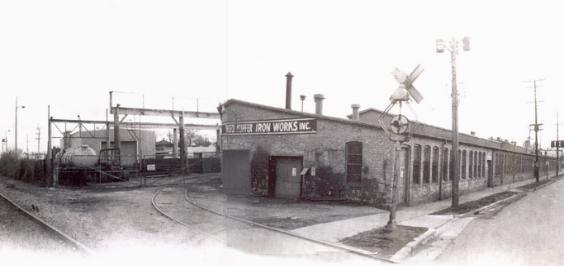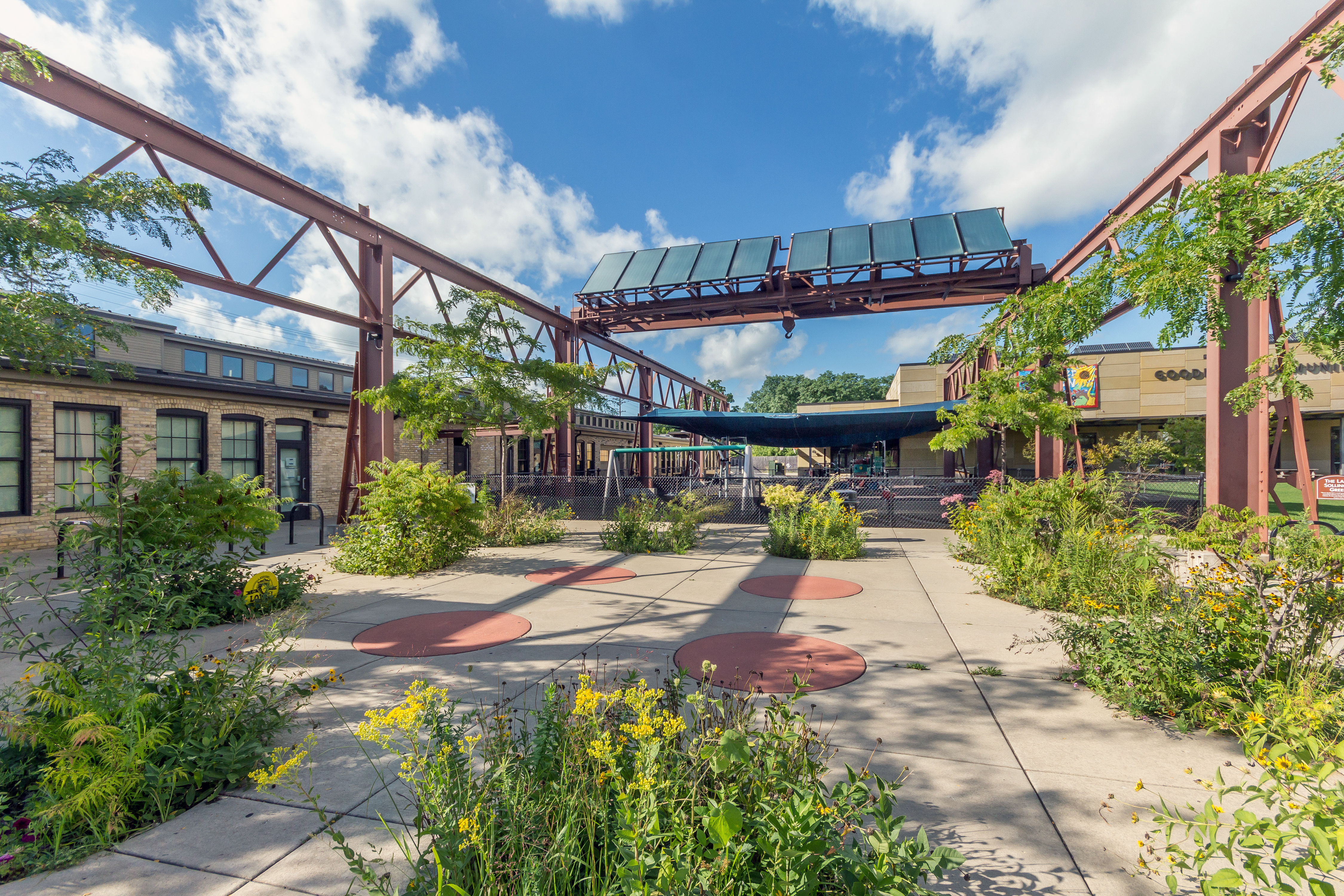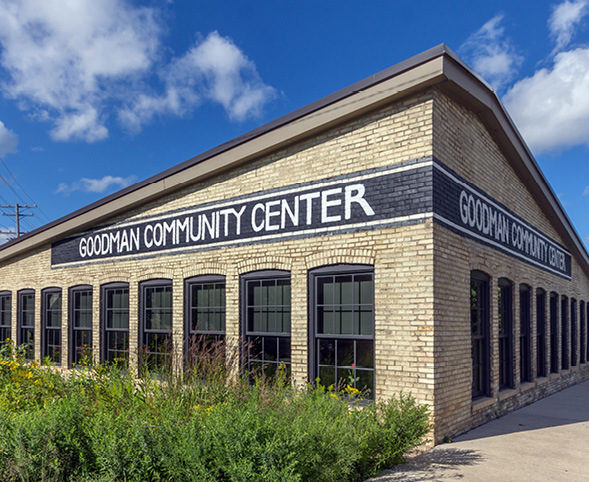The original section of the Ironworks building was erected around the turn of the last century.
The building, a "one-story production shed," is a heavy-timber structure 80 feet wide by 180 feet long. It demonstrates a classic factory form characterized by an abundance of ground floor windows and two rows of high central clerestory windows, maximizing natural light and ventilation. We were told that this was a historically significant site because it was one of very few examples of this type of architecture left in Dane County. So in May 2007, we applied for placement on the National Register of Historic Places and by June we received preliminary approval by the National Park Service. On July 20, 2007, The State Historical Society made it official!
We're thrilled to be preserving our local industrial history, and it's a tremendous financial boost as it makes the Center eligible for Historic Tax Credits, which brought in significant additional funding to help fund our new facility.
In 2019 we reconfigured and revitalized the building by adding early childhood and elementary classrooms, consolidating all fitness programs in the gym building, creating more spaces for seniors, enlarging the food pantry and adding more space for the community to gather.
A rich industrial history

Four industrial manufacturers operated in the Ironworks building over the last century, beginning with the American Shredder Company. In 1906 the Steinle Turret Lathe Machine Company took over and added on to the building until it ran the entire length of the block. In 1940 the Theo Kupfer Iron Works purchased the building and a year later, erected the 320-foot long steel gantry that has become a neighborhood landmark. In 1990 Durline Scale Company moved in.
By 2001, investors were exploring commercial redevelopment of the site. We were able to purchase the property at the end of 2005, thanks to an anonymous donation.
The American Shredder Corporation organized in March 1903. In May 1903, the American Shredder Corporation, which manufactured and sold "corn self-feeders, corn huskers and other machinery and supplies," signed a contract to purchase the property at 149 Waubesa Street.
The American Shredder Corporation, however, appears not to have been very successful. By July 1906, the firm had granted George A. Steinle an option to lease the plant for his new enterprise, the Steinle Turret Machine Company. Circa 1920, a narrow addition was constructed connecting the 1917-18 office building with the main block. The Steinle Turret Machine Company prospered through the 1920s, maintaining a workforce of 400. During the early 1930s, the firm faltered, and was conducting only limited business by 1934. From at least 1939 until 1948, the Kleenaire Corporation, which sold air conditioning equipment, occupied the 1911 section of the Steinle Building (135 Waubesa Street).
On 12 October 1940, the Theodore Kupfer Iron Works acquired the property at 149 Waubesa Street. The next year they erected the 320-foot-long steel gantry behind it adjacent to the railroad tracks. That firm was established by Theodore Kupfer, Sr., in November 1894 at 629-31 East Mifflin Street. The Kupfer Iron Works originally produced feed cookers and steamers, sugar kettles, cauldrons, and ornamental ironwork, including the decorative iron details of the Mount Horeb Opera House. In the early twentieth century, the firm became a machine shop, and then gradually converted to fabricating structural steel after World War I.
During its time at the Ironworks site, the Kupfer foundry was used to manufacture steel fabrications weighing up to five tons, including, in 1943, 30-foot long submarine engine mounting bases. During the 1960s Kupfer Ironworks fabricated and erected steel throughout the Midwest for bridges and overpasses for the United States Interstate system. It also fabricated steel for the Dane County Coliseum, the United Bank Building, the Concourse Hotel, the Wisconsin Telephone Building on West Washington Street (now Network 222), many University of Wisconsin buildings, and the award-winning Tenney Park footbridge.
By the early 1980s, the widespread use of prefabricated steel had reduced the demand for custom steel fabrication such as Kupfer produced. In 1983, the company’s workforce was cut from 200 to 40. Kupfer Iron Works closed in 1985.
The Steinle Building remained vacant until Durline Scales and Manufacturing purchased the property in 1990. This firm produced large truck scales in the building until November 2003, when the operation relocated to Rockford, Illinois.
In 2001, Ironworks Development, LLC acquired the building with a vision of creating commercial condominiums, but when the Atwood Community Center expressed interest in the site, they offered to sell it to the Center. We purchased the site at the end of 2005, thanks to an anonymous donation.
Green, green, green

Right from the beginning, our staff and board wanted Ironworks to be as green and sustainable as possible. That commitment influenced every decision - from the architect and construction contractor we selected, to the landscaping and furnishings we chose. Early on, we worked with the Madison Environmental Group on a recycling plan for the demolition and construction phases which included crushing and recycling existing concrete, recycling all scrap metal and wood and recycling all lighting fixtures and bulbs. All of the concrete that was demolished on-site was ground and reused as the base for our parking lots and gym.
As we did our research, we took our cue from two leading green building management and certification systems: LEED (Leadership in Energy and Environmental Design) and the Green Globes system. While we did not pursue certification from either program because of costs involved, we followed their guidelines. Our architects tallied up the LEED points we would qualify for and determined that the building would likely meet the LEED Gold standard ranking.
For a list of the sustainable features of the Goodman Community Center, click here.

